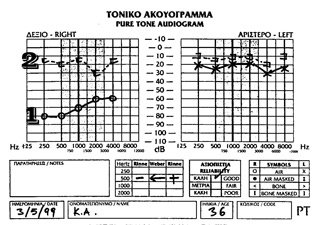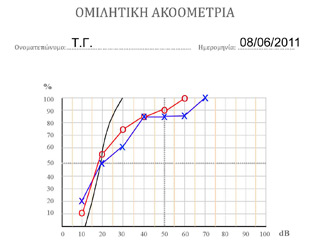Examination of Hearing
Examination of hearing in adults and co-operative children is done with the Pure Tone Audiogram and the Speech Audiogram.

The Pure Tone Audiogram is a test which is dependent upon the replies of the examined subject. With the help of a special device, we present sound (tone) of various frequencies at decreasing intensity, and we note the lowest intensity audible at each frequency (musical note). The sound is first presented with headphones and then with a special bone conductor, which is a minute speaker, fixed on the bone behind the ear. The diagram which is drawn during the examination by the earphones, corresponds to the hearing through the air, and is called air conduction. The sound which is presented to the patient my means of the bone conductor bypasses the conduction mechanism of the ear (eardrum, ossicles) and reaches the organ of hearing through the surrounding bone. Therefore, the second curve, drawn during the examination with the bone conductor, expresses the ability of the ear to hear, regardless of the condition of the coduction mechanism (bone conduction curve).
The hearing is measured in deciBels. The higher the position of the patient’s response on the diagram, the better the hearing. Normal pure tone audiogram ranges between 0 and 20 deciBels. In normal hearing, the curves of air and bone conduction are at similar levels, within normal limits. If there is a defect in the eardrum or the ossicles, the air conduction is often impaired, but the bone conduction is expected within normal limits. In other pathological conditions, both curves are lowered, and, depending upon the nature of the problem, can be identical or different.

At Speech Audiogram, the examiner does not present tones to the patient, but spoken words, usually previously recorded on a CD. The intensity is gradually lowered, and the patient is asked to repeat the words he/she hears. At the Speech diagram, we note the percetage of the correctly reproduced words at each intensity level. Speech Audiogram reflects speech intelligibility, regardless of the tone audibility. It is important in specific conditions of the ear, and is always performed before ear surgery.